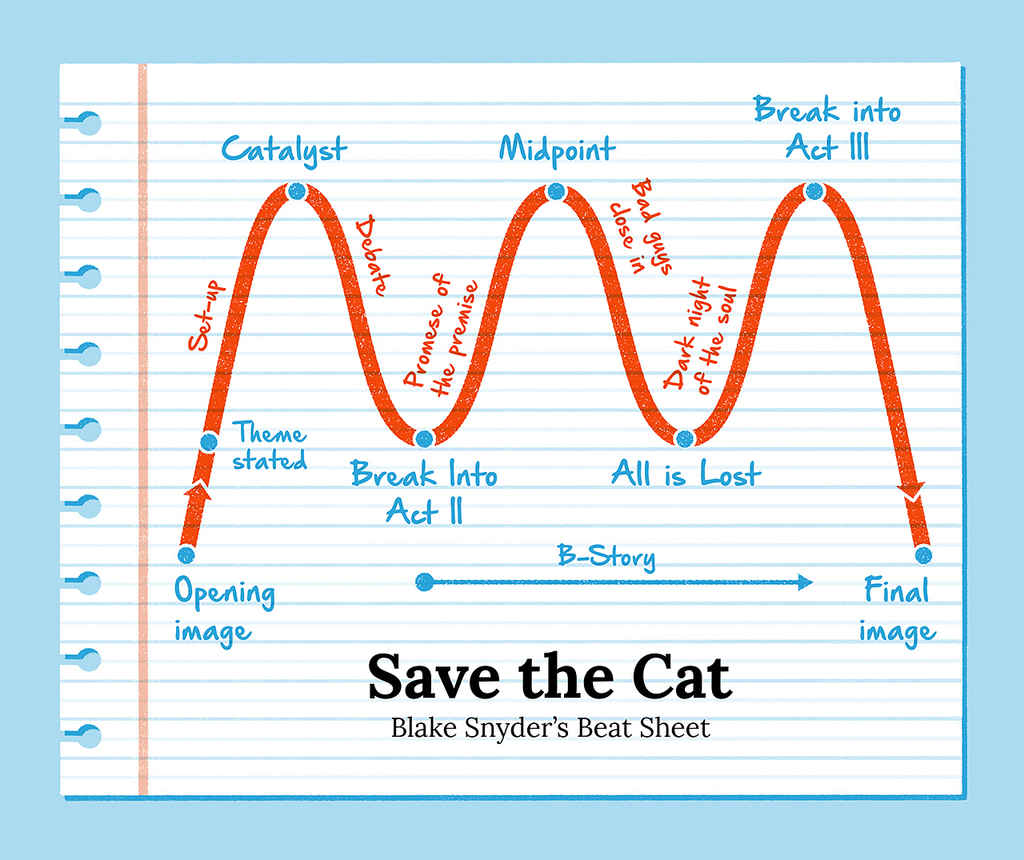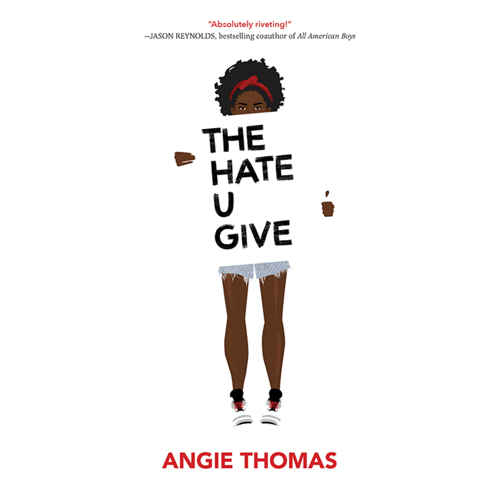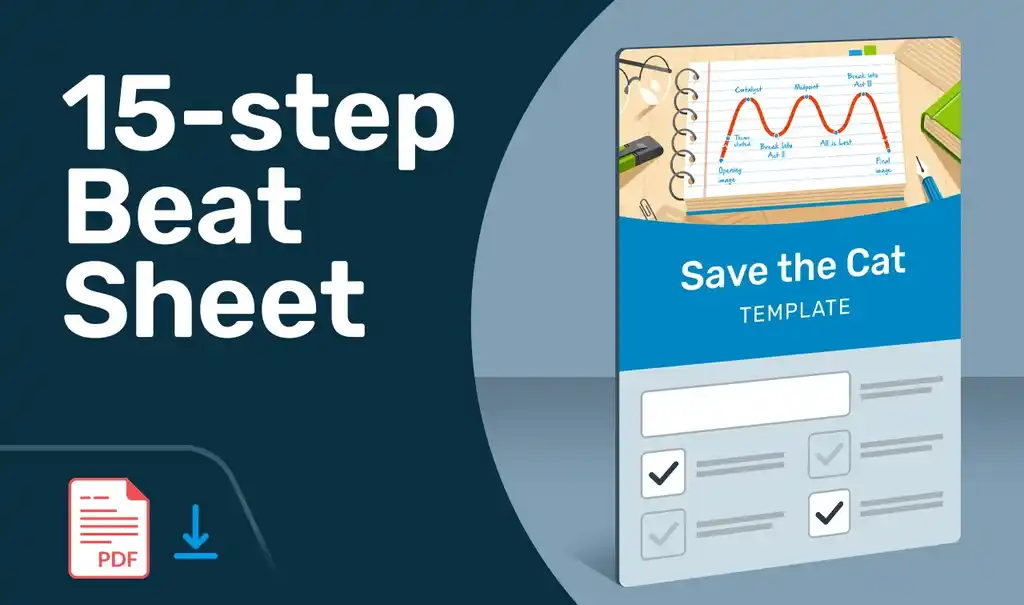Guides • Perfecting your Craft
Last updated on Sep 19, 2022
Save the Cat Beat Sheet: The Ultimate Guide (+ Template)
Save the Cat is a writing manual, story structure, and plotting method devised by Hollywood screenwriter Blake Snyder. Originally intended for writing screenplays, the method is now also popular with novelists, providing writers with a framework to plan their story with theme, character development, and pacing in mind.
If you're already sold on the idea and don't need us to walk you through it, why not take the Save the Cat beat sheet for a spin yourself and use it to outline your own story?
To keep things simple, we've created a fillable template for you to use. It features the recommended page allotments for each beat based on the length of your work so you can instantly tell where your story is sagging.
Enter your email address to download our beat sheet template!
You’ll get it in your email inbox right afterward.
If you’re looking for more detail about the Save the Cat method, its background, and a breakdown of the individual steps in action, read on.
What is the Save the Cat Beat Sheet?
Famous for more than just its quirky name, Save the Cat has come to be a well-regarded story manual for writers across media. It takes its name from a moment commonly found in stories where the protagonist does something heroic — like saving a cat — to endear them to the audience. Written by screenwriter Blake Snyder, the book is perhaps best known for its beat sheet: an ordered list of moments that are common to most stories.

This beat sheet has since been adapted for novelists, and the Save the Cat beat sheet has become a tried and tested tool used by storytellers across different media. Let’s get into how the Save the Cat beat sheet (from now on STC) is used to build stories that win over readers of all ages and literary tastes.
The beat sheet details, one by one, every beat that makes up the STC structure, outlining where and in what order each event should occur. An evolution of the classic 3-act structure, Snyder codified his 15-beat outline to better manage the second act, which screenwriters often struggle with.
“Like a swimmer in a vast ocean, there was a lot of open water between those two Act Breaks. And a lot of empty script space in which to get lost, panic, and drown. I needed more islands, shorter swims.”

Make sure your story is in tip-top shape!
The best editors are on Reedsy. Sign up for free and meet them.
Learn how Reedsy can help you craft a beautiful book.
The 15 steps of Save the Cat
Since Snyder’s sheet was originally created for screenwriting, the bracketed number by each beat is the page or pages that it would take up of a standard 110-page screenplay. The beats are as follows:
- Opening Image [1]: An opening snapshot.
- Theme Stated [5]: We are introduced to the central theme or lesson of the story.
- Set Up [1-10]: The hero and the 'ordinary world' are introduced.
- Catalyst [12]: Something happens that sets the story in motion.
- Debate [12-25]: The hero is hesitant to take action.
- Break Into Two [25]: The hero takes up the challenge.
- B Story [30]: The subplot kicks in, introducing a character who helps the hero in their transformation.
- Fun and Games [30-55]: The hero in the throes of their challenge or journey.
- Midpoint [55]: The stakes are raised.
- Bad Guys Close In [55-75]: Things start going downhill for the hero.
- All is Lost [75]: Things go from bad to worse. The hero hits rock bottom.
- Dark Night of the Soul [75-85]: Faced with defeat, the hero must reckon with their loss and how they got there.
- Break Into Three [85]: The hero realizes a truth that’s been evading them all this time.
- Finale [85-110]: Putting their new awareness into action, the hero conquers the bad guys.
- Final Image [110]: A snapshot that mirrors or contrasts the opening image.
The writer should be able to describe each beat with just one or two sentences. As Snyder says, “I learned that if I can’t fill in the blank in one or two sentences — I don’t have a beat yet! I am just guessing. I am treading water, about to drown.”
Now we’re going to take a look at what each beat involves. We’ll map each beat onto Angie Thomas’s bestseller, The Hate U Give. Note: spoilers ahead.

First, some background. The protagonist Starr is a teenage girl who finds herself caught between her predominantly Black community of Garden Heights and her elite, predominantly white school. Struggling to belong to either place, Starr’s quandary intensifies when her childhood friend Khalil is shot and killed by a police officer. As the only witness, Starr must decide how far she is willing to put herself on the line to get justice for Khalil, while tensions in her personal life and between police and rival gangs in Garden Heights heighten.
💡 The screenplay portioning has since been adapted for authors as equivalent proportions of a book’s length. These are listed as percentages beside each act. We have also included the relative proportions as each beat comes in The Hate U Give.
1. Opening Image (1%)
This is a snapshot that instantly introduces us to the present world of the hero. In a film, this is an actual visual image whereas, in a novel, you need to conjure up a vivid scene that draws your reader in and sets the tone of what is to come.
📖 We enter Starr's world — 0%
As The Hate U Give opens, Starr feels out of place at a party in Garden Heights. “Between the headache from the loud-ass music and the nausea from the weed odor, I’ll be amazed if I cross the room without spilling my drink”.
2. Theme Stated (5%)
This beat introduces the central idea, or life lesson, that the hero will discover over the course of the story.
📖 Injustice comes to the forefront — 3%
Starr’s childhood friend Khalil reveals the meaning of Tupac’s THUG LIFE slogan, an acronym for “The Hate You Give Little Infants F***s Everyone” — that the injustices served to Black people as kids end up having negative consequences for all of society.

3. Set-up (1-10%)
Here comes a deeper, more detailed look at the status quo of the hero’s world, before it is violently shaken up. Crucial details about the character flaws they might be working to overcome will show up here too.
📖 Getting to know Starr better — 0-3%
Starr's childhood friend Kenya suggests that going to an elite school has made Starr think she’s too good for the neighborhood — which holds a kernel of truth. Despite her understanding of the systemic oppression of Black people, Starr is somewhat judgmental of the people at the house party.
4. Catalyst (10%)
Also known as the inciting incident in other structures, this major plot point is the single moment that sets the hero on the course they will pursue over the story.
📖 A tragic inciting incident — 5%
Khalil and Starr are pulled over. Khalil is shot and killed by a white police officer with badge number 115. Starr is the only witness to the killing.
5. Debate (10-20%)
Following the catalyst, the hero resists the challenge presented by the inciting incident.
📖 Starr is torn — 7-11%
Starr worries about becoming hypervisible and targeting by cops if she is identified as the witness to Khalil’s murder. Fearing for her safety, she decides to keep it a secret that she was there.
6. Break Into Two (30%)
After their moment of doubt, the hero decides to take on the challenge that’s been thrown their way and sets about dealing with the fall-out of the inciting incident.
📖 Taking up the challenge — 11%
Convinced by her police-detective uncle that testifying will help Khalil get justice, Starr presents herself to the police as an anonymous witness.

7. B Story (22%)
The B story, or subplot, is introduced fairly early and continues to run alongside the main plot for most of its duration. The B story usually involves a character (often a romantic interest) who’s integral to helping the hero undergo their transformation.
📖 The reader meets DeVante (32%)
Starr meets DeVante, a drug dealer who is on the run from the leader of the gang he belongs to for stealing money. Starr’s father invites him to come and work alongside Starr in his shop. As she gets to know DeVante, she will learn of the hardships which led him to this lifestyle, and in turn, she will begin to understand what drives the choices people make in Garden Heights — choices that she has previously judged.
8. Fun and Games (20-50%)
Despite the label, this beat might not actually entail any fun for the characters involved, and is also often referred to as the ‘promise of the premise’. Here is where that action or central conflict that was promised, often in the hook of the story description, is delivered on.
In a superhero story, this is where we get to see them beat up some low-level bad guys; in a detective story, 'fun and games' is where the gumshoe will start tracking down some clues.
📖 Conflict begins to heat up (30-69%)
Meanwhile, the police’s refusal to arrest Officer 115 compels Starr to take her efforts to the next level. She participates in an anonymous news interview and secretly consults with the district attorney working on the case to speak up for Khalil and implicate a local Gang. In an effort to assimilate and maintain friendships at school, Starr lies to her friends about knowing Khalil and hesitates in confronting her friend Hailey for her racist views.
9. Midpoint (50%)
This point signals the culmination of the action of the ‘fun and games’. Stakes are raised by a plot twist that likely takes the form of a false victory — a moment where the hero mistakenly believes they have won
📖 Starr takes the stand (75%)
Despite the pressure she faces from the gang and the police as they try to stop her from speaking out, Starr takes a bold step and testifies in front of a grand jury.
10. Bad Guys Close In (50-75%)
In the wake of the midpoint, tension mounts and things really start to go downhill for the hero.
📖 Our hero faces hostility (76-85%)
Starr's efforts to separate her home and school life start to crumble when a classmate outs her for lying about knowing Khalil. Starr accuses her of racism, and their argument escalates into a physical fight, resulting in Starr's suspension from school.

11. All is Lost (75%)
This is the moment where everything comes crashing down for the hero and they reach rock bottom, where all hope seems lost.
📖 Starr's isolation — 86%
The Grand Jury chooses not to indict Officer 115 for Khalil’s murder. Despite her efforts, Starr has failed to get justice for Khalil and has also been ostracized by her school community.
12. Dark Night of the Soul (75-80%)
In the face of defeat, the hero has a moment of reckoning where they take stock of what they have lost.
📖 A moment of desparation — 87-88%
Viscerally angry and pushed to her limits by the sheer injustice, Starr is drawn to the riots she sees taking place on the streets protesting the grand jury decision.
13. Break Into Three (80%)
Through their emotional despair, the hero will find the motivation to keep going thanks to what they have learned over the course of their journey and from the B-Story. With their new optimism and resolution to keep pushing on, the hero springs into action with a new, improved approach to tackling the struggle they are facing.
📖 Hope is reignited — 91%
Starr comes across a peaceful protest. Galvanized by what she has learned through DeVante about how simple it can be to reduce people down to assumptions about their life choices judge without thinking about their humanity or the experiences that have shaped them — as people are doing in justifying Khalil’s murder by calling him a thug — she decides she wants to speak up. She no longer wants to be an anonymous source, but instead put her name and face to the fight against police brutality.

14. Finale (80-99%)
The hero overcomes the problems they were facing with the help of their newly discovered truth.
📖 Starr stands up for what she believes in, and wins — 92-97%
In front of a crowd and national news cameras, Starr admits her connections to Khalil and reveals that she was the witness to his death. She realizes that what she believes in and what’s right is more important than not speaking out for fear of being an outsider to the Williamson community and ends her friendship with Hailey. She also speaks out against the gang member who was pursuing DeVante. The gang member arrested thanks to Starr’s willingness to speak out against him.
15. Final Image (99-100%)
This final moment gives a clear impression of the transformation that has taken place in the hero’s life, and will often mirror the opening image.
📖 Reflecting on the events of the novel — 100%
Starr meditates on Khalil’s life and death — and understands how it relates to her own siblings, DeVante, and real-life victims of police brutality and racial violence. She now knows firmly where she stands, and vows to keep on fighting and speaking up against systemic racial violence.
⚠️ You may have noticed that the proportions in The Hate U Give do not match exactly with those suggested — which were originally designed for screenplays. With novels and other forms of narrative, there is much more 'wiggle room' for the exact placement and length of each beat.
Why do writers use the Save the Cat Beat Sheet?
While the detailed nature of this plot structure is off-putting for some, there are many things that can be learned from it, even if you don’t want to follow the prescribed order or placement of the beats.
It’s a lifeline for outlines
Whether you’re new to the writing game or a seasoned pro struggling unexpectedly with writer’s block, plotting an outline is a process that many find useful. The richly detailed nature of the 15 beat sheet means that by simply filling in each beat, writers can take an initial skeleton of a concept to a full-fledged story in a matter of minutes, or simply drum up inspiration for where a story might go next.
To see the STC beat sheet in action, watch our YouTube video where Shaelin uses Snyder’s beat sheet to plan a novel from a basic concept in just twenty minutes.
Balance is built-in
For some, the problem isn’t not knowing what to say, but rather, not knowing when to stop. With so many great ideas bubbling away, staying in control so they don’t spill over and make your story too long can be a challenge. The specific, proportion allocations provided by the STC beat sheet are a useful reference for pacing and balance so that an appropriate amount of time is devoted to each element.
Your story delivers what readers innately expect
Nowadays, we consume more and more stories on TV or film, so it’s no surprise that the story structure of films and television shows is more familiar to some than those of novels. STC’s screenwriting roots means it taps into stories that more people recognize and intuitively enjoy.
And it’s not just readers who gravitate towards stories reminiscent of films and television. Commercially-minded publishers and agents are increasingly looking out for books that translate across different media. So, if you’re aiming for your book to become a box-office hit, the STC beat sheet is a great place to start.
✍️
Which story structure is right for you?
Take this quiz and we'll match your story to a structure in minutes!
Despite its prescriptive nature, using the STC plot structure doesn’t mean your writing has to be predictable. Whether you follow it to a tee or just refer to it every once in a while, the STC method can be used as the starting point to get all your ideas in order so that you can start composing an exciting story that will wow your readers.


